
Valor In The Atlantic: Returning to Monitor National Marine Sanctuary
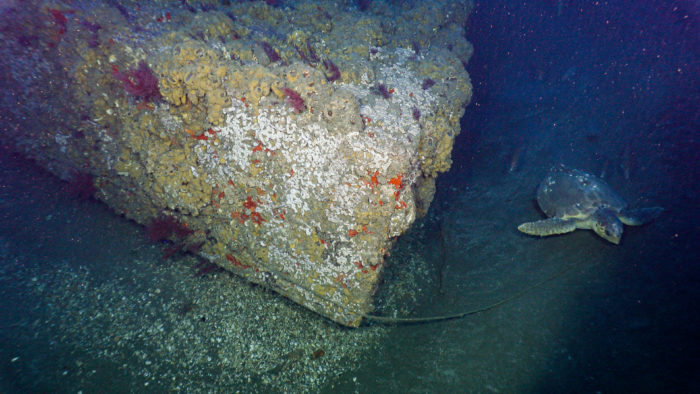
A sea turtle sneaks into view of the USS Monitor’s bow during the Valor in the Atlantic Expedition. (Credit: GFOE/NOAA)
Written by Mark Losavio, Monitor National Marine Sanctuary Media/Outreach Coordinator
2022 is a big year for your National Marine Sanctuary System! Not only are we celebrating 50 years of Sanctuaries but one in particular is really going all out! In May, Monitor National Marine Sanctuary kicked off a summer of Spectacular with an expedition that had been long in the making!
Located sixteen and a half miles off the coast of Cape Hatteras, North Carolina, Monitor National Marine Sanctuary is our nation’s first of 15 National Marine Sanctuaries. Designated in 1975 to protect the wreck of the iconic Civil War ironclad USS Monitor, after its discovery in 1973, it manages a small area, just a one mile diameter column of water surrounding the vessel, but the story reaches far. Built as an answer to the Confederacy’s CSS Virginia, Monitor’s life span was short but impactful. Their meeting at the Battle of Hampton Roads is considered to be the point in history that marked the end of wooden naval warfare and birth of iron warships.. The vessel’s location was a mystery for more than a century until a dream team consisting of North Carolina’s Department of Cultural Resources, Duke University, Massachusetts Institute of Technology, National Geographic and the National Science Foundation discovered it.
Explore Spectacular
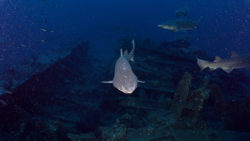
Sand tiger sharks swim over USS Monitor with shipwreck’s boilers in the distance.(Credit: GFOE/NOAA)
So much of Monitor National Marine Sanctuary’s identity can be tied to exploration. From the discovery of the vessel to the recovery of its most iconic artifacts and even the investigation of the many other ships that share its waters off the North Carolina coast. But to be honest, getting to the Monitor wreck itself can be…challenging. At a depth of 240 feet the dive itself is not one that many can do and its location on the shifting sands of the Outer Banks make conditions above and below the waves unpredictable. The culprit of these hazardous waters, and the reason why they end up as the resting place for so many vessels across American history is the fact that two major ocean currents, The Gulf Stream and the Labrador current, collide around Cape Hatteras.
These physical challenges are part of the reason why NOAA has not been able to do a sustained survey of the ironclad in almost 20 years. Using Remotely Operated Vehicles (ROVs) and sonar we can put eyes on these wrecks without getting a wetsuit, well… wet!! So working with ROVs from the Global Foundation for Ocean Exploration were able to do just that! In May, our team embarked on the Valor in the Atlantic Expedition to visit Monitor and study the region’s maritime cultural landscape which includes several wrecks from World War II’s Battle of the Atlantic. Teaming up with the Global Foundation for Ocean Exploration, National Centers for Coastal Ocean Science, and our friends at the North Carolina Office of State Archeology, we visited the wrecks of Monitor, E.M. Clark, Malchace, Bluefields, and U-576.
The coolest aspect of this expedition is that each dive was live streamed to the public for anyone to join in and watch. This both allowed experts from anywhere in the world to dial in and comment live on what the science team was seeing while also allowing any member of the public to tune in and ask questions to drive the exploration.
The Dives
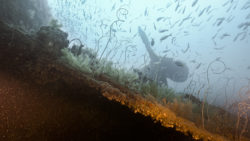
A close look at the benthic organisms that call E.M. Clark home. Many fish and corals, including whip corals, call E.M. Clark home and the propeller can be seen in the background. (GFOE/NOAA)
Monitor: Star of the show and the primary reason Monitor National Marine Sanctuary pioneered this mission! We were able to get cameras down on Monitor on Day One and for two additional days for some spectacular views! The vessel is so full of life that the ROV actually had to compete with some pretty gnarly traffic. Sea Turtles, stingrays and sand tigers abound, the science team was in awe of the vessel’s integrity. After all these years Monitor has lost very little of what made it special! The remarkable condition of the vessel continues to provide a refuge for the fish and coral species of North Carolina. These dives also gave ecologists a glimpse into the spread of the invasive lionfish that were first spotted on rocky reefs in the region over 20 years ago.
E.M. Clark : The largest intact representation of a WWII tanker that can be found near North Carolina’s shores. At a depth of 260 feet, E.M. Clark was a majestic sight to behold, easily identifiable by its remarkably intact hull and gigantic propeller, this wreck gave us two days (and one night) of beautiful footage! Each dive on this vessel rewarded us with beautiful visibility and a wide array of life! Schools of fish, shivers of sharks, and yes there was a shocking amount of lionfish on this wreck. A previous visit to the wreck in 2009 did not report lionfish so this year’s visit was eye opening.
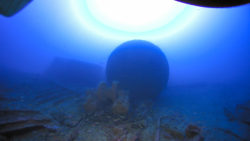
A shadowy glimpse of the boilers that make Malchace identifiable. (GFOE/NOAA)
Malchace: This vessel was not in our planned itinerary, but when the currents picked up around E.M. Clark and Monitor the call was made to try a site further south from the operating area. Malchace is a WWII-era freighter that rests in just over 200 feet of water southeast of Ocracoke. At this site the ecologists from NCCOS made special mention of the unique coral species that can be found on these wrecks and play a positive ecological role.The current was so calm that the ROV team was able to get a good look at some of the benthic community that lives on the vessel.
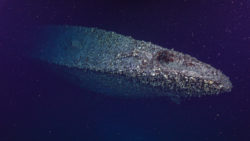
Bow of U-576, now home to a thriving benthic community. (GFOE/NOAA)
Bluefields and U-576 : These WWII sites are unique in that they are the only ones in U.S. waters where the victim and aggressor lie next to each other from the same battle. Both sites lie just over 1000ft from each other in around 700ft of water(which made it easy to visit them on the same day). The deepest dives of the expedition, the science team found a very different biological community on these wrecks. At both sites there were few sharks and far more grouper, huge lumbering fish that are commonly found patrolling reefs. This was also a good opportunity to get a close up of some very charming invertebrate communities.
While we strive to explore and learn more about Monitor and its new role as an oceanic oasis for marine life, we still like to learn and share Monitor’s history, from the inception of the Ironclad Board to today! That’s why we are teaming up with The Mariners’ Museum and Park to hold a celebration this Saturday to mark 20 years since the famous ericsson turret broke the surface and became a cornerstone of The USS Monitor Center’s artifact conservation efforts.
Come join us!
